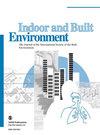Prediction of transmission routes of respiratory infectious diseases in indoor environment: Based on droplet evaporation and sedimentation analysis
IF 2.9
3区 工程技术
Q2 CONSTRUCTION & BUILDING TECHNOLOGY
引用次数: 0
Abstract
Many respiratory infectious diseases are believed to be transmitted from person to person through droplet nuclei in the air or contact with droplet-contaminated surfaces. Most studies related to droplet evaporation only focus on the evaporation process, without dividing the transmission routes of diseases caused by droplet evaporation. In this paper, the actual size of droplet nuclei was analyzed, and droplet evaporation and the changes in component content were predicted. Especially considering the dynamic effect of evaporation on droplets size change, a more realistic sedimentation model was established, and the probability of pathogen transmission through different routes and the corresponding droplet size distribution range were analyzed. The results showed that the size of droplet nuclei and the rate of the evaporation process together determined the time required for droplet evaporation. The number of droplets still suspended in the air after the end of evaporation is much higher than the number of droplets settling on the ground. In addition, the differences in component content during the evaporation process may affect the inactivation of pathogens in droplets. This study provided a reference for the prevention and control strategies of respiratory infectious diseases in indoor environments.预测室内环境中呼吸道传染病的传播途径:基于液滴蒸发和沉降分析
许多呼吸道传染病被认为是通过空气中的飞沫核或接触被飞沫污染的表面在人与人之间传播的。大多数与飞沫蒸发有关的研究只关注蒸发过程,而没有划分飞沫蒸发导致疾病的传播途径。本文分析了液滴核的实际大小,并预测了液滴蒸发和成分含量的变化。特别是考虑到蒸发对液滴大小变化的动态影响,建立了更符合实际的沉降模型,并分析了病原体通过不同途径传播的概率及相应的液滴大小分布范围。结果表明,液滴核的大小和蒸发过程的速率共同决定了液滴蒸发所需的时间。蒸发结束后仍悬浮在空气中的液滴数量远远高于沉降在地面上的液滴数量。此外,蒸发过程中成分含量的差异可能会影响液滴中病原体的灭活。这项研究为室内环境中呼吸道传染病的预防和控制策略提供了参考。
本文章由计算机程序翻译,如有差异,请以英文原文为准。
求助全文
约1分钟内获得全文
求助全文
来源期刊

Indoor and Built Environment
环境科学-工程:环境
CiteScore
6.40
自引率
25.00%
发文量
130
审稿时长
2.6 months
期刊介绍:
Indoor and Built Environment publishes reports on any topic pertaining to the quality of the indoor and built environment, and how these might effect the health, performance, efficiency and comfort of persons living or working there. Topics range from urban infrastructure, design of buildings, and materials used to laboratory studies including building airflow simulations and health effects. This journal is a member of the Committee on Publication Ethics (COPE).
 求助内容:
求助内容: 应助结果提醒方式:
应助结果提醒方式:


